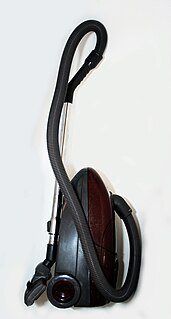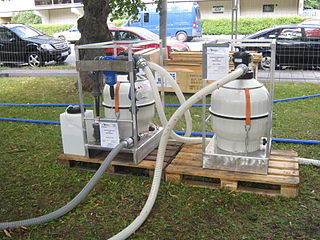
A vacuum cleaner, also known simply as a vacuum or a hoover, is a device that causes suction in order to remove debris from floors, upholstery, draperies and other surfaces. It is generally electrically driven.

Water purification is the process of removing undesirable chemicals, biological contaminants, suspended solids, and gases from water. The goal is to produce water fit for specific purposes. Most water is purified and disinfected for human consumption, but water purification may also be carried out for a variety of other purposes, including medical, pharmacological, chemical, and industrial applications. The methods used include physical processes such as filtration, sedimentation, and distillation; biological processes such as slow sand filters or biologically active carbon; chemical processes such as flocculation and chlorination; and the use of electromagnetic radiation such as ultraviolet light.

A humidifier is a device, primarily an electrical appliance, that increases humidity (moisture) in a single room or an entire building. In the home, point-of-use humidifiers are commonly used to humidify a single room, while whole-house or furnace humidifiers, which connect to a home's HVAC system, provide humidity to the entire house. Medical ventilators often include humidifiers for increased patient comfort. Large humidifiers are used in commercial, institutional, or industrial contexts, often as part of a larger HVAC system.
The Disaster Assistance Response Team (DART) is a rapidly deployable team of 200 Canadian Forces personnel. It provides assistance to disaster-affected regions for up to 40 days. DART's headquarters is located in Kingston, Ontario. DART was created by the Canadian government in 1996 in the aftermath of the inadequate response to the 1994 Rwandan genocide, when Canada's aid arrived after the peak of a cholera epidemic. The government determined that it would be of the utmost importance in many disasters if it was able to rapidly deploy a group of people until long-term aid arrived. DART has an annual budget of CA$500,000 , although during specific incidents the Parliament of Canada can choose to temporarily allocate millions of dollars to DART to fund their response effort. For example, Operation Torrent, the aid mission to Turkey in the wake of the 1999 earthquake which left 17,000 people dead, saw CA$15 million used by DART in the response.
Music for Relief was founded by the band Linkin Park in response to the 2004 Indian Ocean tsunami. Throughout its first twelve years, thanks to incredible artist partners, donors and supporters, Music for Relief responded to more than 30 natural disasters across four continents providing immediate relief and funding long-term recovery with a focus on sustainability. Always thinking about collaboration, in March 2018, Music for Relief announced it would join forces with Entertainment Industry Foundation to amplify the results of its disaster relief and recovery work.
An oxygen concentrator is a device that concentrates the oxygen from a gas supply by selectively removing nitrogen to supply an oxygen-enriched product gas stream.
The United Methodist Committee on Relief (UMCOR) is the global humanitarian aid and development organization of the United Methodist Church (UMC). UMCOR is a nonprofit 501(c)3 organization operated under the auspices of the General Board of Global Ministries. One hundred percent of donations are directed to an earmarked project or relief effort. Administrative expenses are funded by an annual offering collected by United Methodist churches on UMCOR Sunday.
LifeStraw is a brand that manufactures water filtration and purification devices. The first product was designed as a portable water filter "straw". It filters a maximum of 4000 litres of water, enough for one person for three years. It removes almost all of waterborne bacteria, microplastics and parasites. A bottle was later developed which incorporated a LifeStraw cartridge into a 0.65 litres (22 US fl oz) BPA-free plastic sports water bottle. In addition to these portable filters, the manufacturer also produces high-volume purifiers powered by gravity that also remove viruses. These are designed for family and community use.

Portable water purification devices are self-contained, easily transported units used to purify water from untreated sources for drinking purposes. Their main function is to eliminate pathogens, and often also of suspended solids and some unpalatable or toxic compounds.

Ceramic water filters (CWF) are an inexpensive and effective type of water filter that rely on the small pore size of ceramic material to filter dirt, debris, and bacteria out of water. This makes them ideal for use in developing countries, and portable ceramic filters are commonly used in backpacking.

Humanity First is an international charity that provides disaster relief and long term development assistance to vulnerable communities in 52 countries across 6 continents. The organisation is run by volunteers with diverse skillsets across the world and has access to thousands of extra volunteers worldwide. Volunteer staff in all areas often pay their own expenses to support the international projects.

The LifeSaver bottle is a portable water purification device. The bottle filters out objects larger than 15 nanometres.
Slingshot is a water purification device created by inventor Dean Kamen. Powered by a Stirling engine running on a combustible fuel source, it claims to be able to produce drinking water from almost any source by means of vapor compression distillation, requires no filters, and can operate using cow dung as fuel.
Reverse osmosis (RO) is a water purification process that uses a partially permeable membrane to separate ions, unwanted molecules and larger particles from drinking water. In reverse osmosis, an applied pressure is used to overcome osmotic pressure, a colligative property that is driven by chemical potential differences of the solvent, a thermodynamic parameter. Reverse osmosis can remove many types of dissolved and suspended chemical species as well as biological ones (principally bacteria) from water, and is used in both industrial processes and the production of potable water. The result is that the solute is retained on the pressurized side of the membrane and the pure solvent is allowed to pass to the other side. To be "selective", this membrane should not allow large molecules or ions through the pores (holes), but should allow smaller components of the solution (such as solvent molecules, i.e., water, H2O) to pass freely.

Wine To Water is a non-profit organization committed to supporting life and dignity for all through the power of clean water. The organization was founded by Doc Hendley in 2007.

GlobalMedic is a non-sectarian humanitarian-aid non-governmental organization based in Etobicoke, Toronto, Ontario, Canada and the operational arm of the David McAntony Gibson Foundation (DMGF), a registered Canadian charity. It provides disaster relief to large scale catastrophes around the world and also carries out humanitarian capacity building programs in post-conflict nations. Time magazine recognized the work of GlobalMedic in its 2010 Time 100 issue. Rahul Singh, a Toronto paramedic, founded the David McAntony Gibson Foundation in 1998 in honour of a best friend who lost his life the same year.
The article on water issues in developing countries includes information on scarcity of drinking-water, poor infrastructure for water access, floods and droughts, and the contamination of rivers and large dams in developing countries. Over one billion people in developing countries have inadequate access to clean water. Barriers to addressing water problems in developing nations include poverty, climate change, and poor governance.

An Emergency Response Unit (ERU) is an international standardized disaster relief unit established by the International Federation of Red Cross and Red Crescent Societies. It can provide specific services where local infrastructure is damaged or temporarily out of use.
Aktion Deutschland Hilft e.V. – Bündnis deutscher Hilfsorganisationen (ADH) with headquarter in Bonn is a connection of German Aid agencies for Humanitarian aid, with the target to help faster and more efficient through coordination and combination of efforts in case of a disaster and to raise Donations together.

Emergency sanitation is the management and technical processes required to provide sanitation in emergency situations. Emergency sanitation is required during humanitarian relief operations for refugees, people affected by natural disasters and internally displaced persons. There are three phases of emergency response: Immediate, short term and long term. In the immediate phase, the focus is on managing open defecation, and toilet technologies might include very basic latrines, pit latrines, bucket toilets, container-based toilets, chemical toilets. The short term phase might also involve technologies such as urine-diverting dry toilets, septic tanks, decentralized wastewater systems. Providing handwashing facilities and management of fecal sludge are also part of emergency sanitation.












